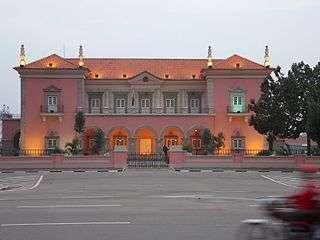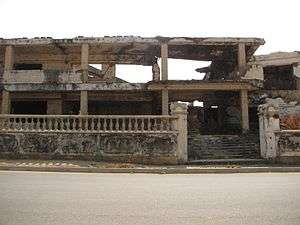Huambo
Huambo is a city in Central Angola, and capital of the Huambo Province. It is one of the largest provincial cities in Angola, comparable in size with Lubango and Lobito/Benguela. Once called Nova Lisboa, it was designed in 1912 to be the new capital of Angola, and the beauty of that era is still apparent. Angola's civil war took a massive toll on Huambo and its surrounding areas, leaving most buildings in the city full of bullet holes. In recent years, reconstruction efforts have changed the face of the city, and the economy is booming as businesses reinvest.
Understand

Huambo sits in the center of the traditional area of the Ovimbundu people (who speak Umbundu). During previous centuries the Ovimbundu were organized into several independent kingdoms. The Portuguese came into contact with these kingdoms in the 1500s, and the Ovimbundu soon proved themselves to be capable traders, creating trade networks from the Portuguese port town of Benguela all the way into modern-day DRC (Katanga province) and Zambia. At the beginning of the 1900s, the Portuguese turned from economic to military interests, and soon conquered the Central Highlands. It was in the immediate aftermath of this conquest that Huambo city was built.
Portuguese General Norton de Matos resided at the Quibala fortress while he laid plans for the new city of Huambo, established in 1912. The current layout of the city bears the marks of his Portuguese-style organization, with a monumental rotunda surrounded by government edifices, a beautiful central garden areas, and a commercial division with a clear grid street plan. These areas were devastated during the civil war, but the current government has rehabilitated the area very quickly, giving it an Angolan flair on top of the Portuguese design.
The old Portuguese center of the city is now surrounded by Angolan "bairros" which swelled during the war years with refugees from the surrounding countryside. The bairros are crowded and disorganized, and most roads are still packed dirt. With every month that passes, the municipal administration builds more roads, connects more houses to city electricity, and repairs more of the city... but there is still a lot of work to do.
Get in
By plane
TAAG operates flights from Luanda to Huambo (and vice versa) at least once a day. A one-way ticket costs in the range of $160. Flights also arrive on a much reduced schedule from Lubango, Ondjiva, and occasionally other cities.
The Huambo airport, Aeroporto Albano Machado, lies 3.5 km south of the city center. Motorcycle taxis will be waiting to take you anywhere you want to go, but don't let yourself be overcharged. 200 kwanzas should get you anywhere in the main city area.
By train
Passenger trains on the CFB (Caminho de Ferro Benguela) arrive from Kuito twice a week, and probably from Benguela too. The train schedule constantly changes as the last repair work is still being done on the railway, so check schedules and availability once you've arrived in the country.
🌍 Huambo railway station is located about 1,5 km northeast of the city centre.
By bus
Several companies run bus lines between Huambo and other major cities. The most reliable are AngoReal and Macon.
- AngoReal sends about 3 buses each morning from Luanda (Rocha Pinto) to Huambo and vice versa - they leave when they fill up, starting about 05:30. Tickets cost 3000 kwanzas, and can be bought immediately before departure.
- Macon runs buses on a schedule, both morning buses and overnight buses, and operates connections between Huambo and Luanda, Benguela, Lubango, and Santa Clara. Tickets from Luanda or Lubango cost 3000 kwanzas. Check the schedule and buy your ticket one day in advance at any of the Macon offices in your departure city.
Interprovincial "taxis" also provide a more flexible public transportation option, though considerably more dangerous. Many blue-and-white vans and Land Cruiser taxis run the route between Luanda and Huambo, and between every other city destination you might want. You just have to ask locally until you find the location where they load up. Vehicles can be found leaving at all times of day or night. Passage typically costs 4000 kwanzas, though the price may rise if you are carrying lots of baggage, if night is falling, or if there are more passengers than taxi space. Be warned, though: taxi drivers are not known for their safety consciousness nor the mechanical reliability of their vehicles!
By car
If you have your own vehicle, you can get to Huambo on the main highways in the following (roughly estimated) time frames:
- From Luanda, 8 hrs
- From Lobito or Benguela, 4.5 hrs
- From Lubango, 6 hrs
- From Kuito, 2 hrs
- From Menongue, 4.5 hrs
Get around
The easiest way to get around Huambo is on motorcycle taxis. They wait at every corner, or you can flag one down as he drives by. Tell the driver where you want to go, and he'll tell you a price. Prices should be standard depending on the distance (usually 100, 200, or 300 kwanzas), but you, as a visitor, won't know what's fair. So try to bargain your way as low as they'll go, then you know you're getting a fair(er) price.
Be aware that motorcycle drivers are not necessarily safe. Many accidents occur. Ensure that the motorcycle you choose looks in decently good repair and has two good quality helmets. Don't climb on a motorcycle taxi without wearing a helmet.
Blue and white taxi vans are another option, useful if you need to cross from one side of the city to another. They run predetermined routes, and can sometimes be slow because they wait for the taxi to fill up. Listen for a taxi calling your destination. It should cost 100 kwanzas to get to that destination. You can get off earlier on the route, but you'll still pay 100 kwanzas.
Because of the dangers inherent in all forms of public transportation in Angola, it may be better to just plan to walk most of the places you're going. The center of the city is not large, and the climate is usually pleasant (except when it's raining). A 30 minute stroll will get you from the Cidade Alta (uptown) to the Cidade Baixa (downtown).
If driving, be very careful of motorcycles, which will appear suddenly on every side of you. They aren't careful, so you have to be. Also, be aware that many left turns are prohibited, even if not clearly signposted. But you may be able to argue your way out of a traffic ticket by highlighting the lack of signage.
See
Within the city

Start at the Praça de Agostinho Neto in the Cidade Alta. This large and beautiful rotunda is surrounded by the governor's palace, the principal government edifices (easily recognized by their pink color), and the central post office. In the middle of the rotunda is a large monument to the nation's first president, Agostinho Neto. Neto was both a soldier and a poet; the statue pays tribute to both sides of the man - he is dressed in military uniform, but seated on the ground writing. Take the time to read the inscription at his feet. Feel free to take pictures of the monument, but try not to point your camera obviously at the surrounding government buildings, so as not to attract unwanted suspicion. Also, make sure to revisit the Praça at night, when it is (usually) attractively lit.
A 5 minute walk south from the Praça de Agostinho Neto is the Jardim da Cultura. This is Huambo's central park, gorgeously redone in 2008/9. With some luck, you'll find the water fountains spraying, the music playing, and at night, the lights dancing. On the weekend you'll find the park full of locals enjoying the evening. You'll probably also encounter newlyweds taking their wedding photos here. Congratulate them by saying parabens! (pronounced: pah-rah-baynsh).
If you're ready for a drink or a bite to eat, the immediate environs of the Jardim da Cultura provide several options. Otherwise, head eastward. First, you'll encounter several metals statues from the Portuguese era.
Daytrips from the city
Do
Buy
Eat
Drink
Sleep
- 🌍 Hotel Ekuikui I, Rua Torres Garcia, ☎ +244 241 225 380, e-mail: reservas@hotelekuikui.com. Newly constructed, luxury hotel in downtown Huambo.